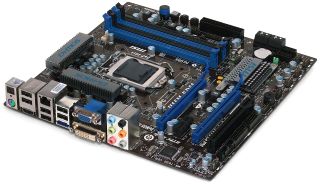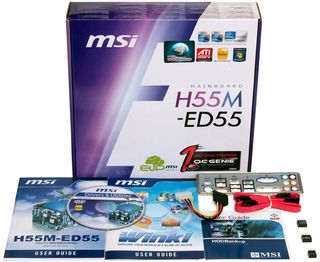Budget Computing: Nine H55 And H57 Motherboards Compared
MSI H55M-ED55
With another gamer-oriented microATX design, MSI is ready to also please the non-gaming crowd with DVI, HDMI, and VGA ports that can support two monitors through a Clarkdale processor’s integrated graphics engine.

MSI keeps overclockers in the loop with a five-phase voltage regulator similar to those on some of its full-sized motherboards, although we wouldn’t shoot for 4.0 GHz on anything more power hungry than a dual-core. MSI even adds its OC Genie hardware overclocking buttons to the H55M-ED55’s front edge to capture the hearts of Clarkdale overclockers.

A pair of PCIe x16-length slots completes the motherboard’s gamer appearance, although the second slot is fed by four half-speed lanes through the platform controller hub. The take-away for graphics card users is that the H55M-ED55 could be a great option for single-card compact-gaming machines, media centers that have gaming capabilities, and with its x16 slot in the top position, even slim-line cases that use a riser card for graphics upgrades. Enhanced overclocking features and a favorable slot layout match this board against several P55 predecessors, including MSI’s own P55M-GD45, while the reasonable selection of on-board video connections attempts to spread its appeal to integrated graphics users.
However, our own build experience tells us that the H55M-ED55’s layout won’t be perfect for some compact system builders. For example, four of the SATA connectors that face forward do a great job of allowing long graphics cards to fit, yet many microATX cases don’t have room to insert cables from this direction. And recent efforts, such as our PC-V351 case review, have proven that putting the front-panel audio connector in the bottom-rear corner is a bad idea.
There’s also the small problem that most mid-market and better microATX cases have a front-panel FireWire port, which is a controller not found on the H55M-GD55. While we can balance the fact that most people no longer use FireWire against the fact that most people hate nonfunctional front-panel connections, we have to wonder how artfully professional builders will be able to disclose this to their customers.
BIOS Features
As a compact-performance design, the H55M-ED55 includes the full range of overclocking features expected of larger, similarly priced “budget enthusiast” models.
Stay on the Cutting Edge
Join the experts who read Tom's Hardware for the inside track on enthusiast PC tech news — and have for over 25 years. We'll send breaking news and in-depth reviews of CPUs, GPUs, AI, maker hardware and more straight to your inbox.



For example, the H55M-ED55 supports setting the CPU up to 0.3V above stock and memory up to 2.43V, perfect for those “suicide run” budget-overclocking competitions. MSI also adds vREF for memory overclockers and GPU voltage for those seeking integrated graphics performance records in 3DMark.


As with its larger siblings, the H55M-ED55 makes tweaking a bit more difficult than it needs to be with its inability to set both memory channels simultaneously in manual mode. Tuners must remember to scroll through the menu and repeat their settings to the second memory channel, although the range of settings is at least adequate.

One of the most useful items MSI provides in the BIOS of every performance motherboard is a user profile page, while this one allows up to six BIOS configurations to be saved in a protected area of the BIOS IC.
Accessories

Layout and overclocking features aside, MSI reminds us that the H55M-ED55 is a value-oriented solution by providing four SATA data cables and a single SATA power adapter in its installation kit.
-
Crashman wintermintDo anyone know how good is the integrated graphics found in these mobos? Can it handle some games?Reply
It's not on the motherboard, it's on the CPU. Different CPU's have different clock speeds for the GPU. And it can't even play most games, let alone play them smoothly:
http://www.tomshardware.com/reviews/intel-clarkdale-core-i5-661,2514-11.html -
liquidsnake718 useless... this is just for HD movies and simple web based games, onboard gpus on motherboards are even better than this intel..... i wonder if this was larrabee...... or if larabee will really come to fruitition as I read in a toms article its basically dead.... however i wonder if this was larrabee.....Reply -
anamaniac I'm sad to see Quantum Force (Foxconn's enthusiast line, such as the Bloodrage) die.Reply
At least Foxconn still makes really cheap stuff...
Honestly though, I'm more interested what's the lowest voltage you can get on stock clocks and DDR3 1066 cas6.
=) -
dertechie wintermintDo anyone know how good is the integrated graphics found in these mobos? Can it handle some games?Reply
The IGP is integrated into the Clarkdale CPU. I believe it is simply a further evolution of the X4500HD, and can at least now claim to be on rough par with ATI's integrated graphics, assuming that AMD hasn't done much to up the ante in the 800-series chipsets. Check the reviews of the i5-661 and the i3-5x0s. The 661 is the fastest IGP they sell (there's a reason reviewers all got that particular chip), at 900 MHz, the others are clocked at 733 MHz or 533 MHz. No, it can't run Crysis.
Larrabee is dead, it wasn't worth it to Intel to actually build it. The project isn't dead, but Larrabee Mk I will never see mass production silicon. -
enzo matrix Why do you guys only ever compare P55 and P57 boards? What about AM3? Or even 775 and AM2+?Reply -
anamaniac wintermintDo anyone know how good is the integrated graphics found in these mobos? Can it handle some games?Reply
http://techgage.com/article/overclocking_intels_core_i5-661/1
Intel i5-661.
CPU at 4.3GHz. IGP at 1133MHz. Both are at stock clocks.
ASUS P7H55D-M EVO
Crysis Warhead (1024x768, assuming low settings), 26FPS.
It can play Crysis. =) -
ta152h enzo matrixWhy do you guys only ever compare P55 and P57 boards? What about AM3? Or even 775 and AM2+?Reply
At least they moved to H55/H57, which is a platform that should sell a lot, rather than the brain-damaged P55 platform, which most sites spend a lot of time trying to convince (not that successfully, based on the bad sales) is a great platform.
Lynnfield/P55 is such a strange product, and appeals to such a limited segment of the market. It's not cheap, but it's a high-end product either. So, you get squeezed by x58, which is the real platform, or LGA 775, and now H55/H57 from below. It's not a big market segment, and I think it makes Intel's line a little confusing to average consumers, especially since the Clarksdale CPUs overlap it in cost from below, and the Bloomfield do from above.
It's obvious Intel didn't want to release CPUs with an IMC for the mainstream until they could move the IGP on-board the CPU. Since the IGP has to use the memory controller, there are compromises however you do it when you have an IMC. You either go to the processor, or you add the logic on the IGP (making it redundant), so Intel avoided that problem by putting it on the processor. The P55 is again neither fish nor fowl. It's got limited PCIe lanes, but doesn't have an IGP either.
There's a small segment where it makes sense. It's power efficient and the performance is only slightly less than Bloomfield in many situations, but I think the average consumer is going to find the H55/H57 much better for their needs (an IGP is critical in this market), and the enthusiast will want the full-blown Bloomfield. For that reason I think these motherboards are significant even though the P55 isn't. Maybe you don't want it, but, you'll probably have a friends/family neighbors asking about a computer with these products. They aren't technical marvels with their weird memory controller placed in the video controller, but aside from the distasteful technical compromises Intel made, they still address the market and needs of most people very well. The only one that is so offensive I could never bring myself to recommending is the new Pentium version. It probably is fine for most people, but it's so offensive, it's painful to recommend. I think LGA 775 is better at that point. Or AMD, of course. -
daniel266 WOW ! one more article about intel !! why im not suprised... hope that this comment dont disapear magically...Reply -
JohnnyLucky Thank you for including audio & video encoding benchmarks and productivity benchmarks.Reply
Most Popular


